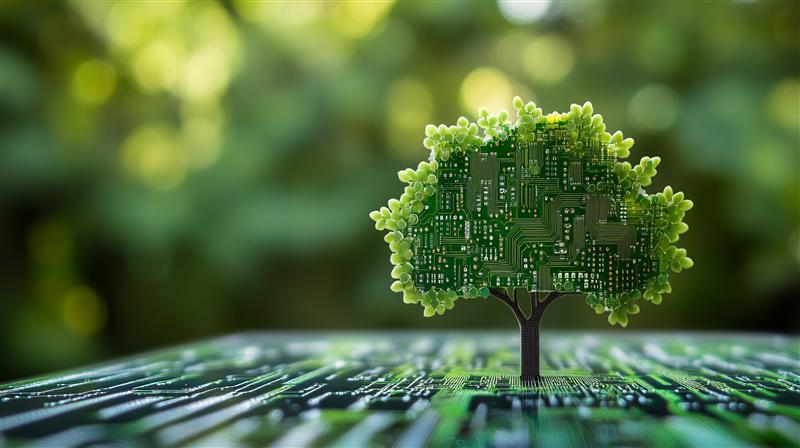
Is AI and green innovation driving the net-zero transition?
Artificial Intelligence and green innovation are two of the most powerful forces currently driving the global net-zero transition.
Artificial Intelligence and green innovation are two of the most powerful forces currently driving the global net-zero transition.
They’re doing so in complementary ways: AI acts as an enabler and accelerator of decarbonisation, while green innovation delivers the technological breakthroughs that make deep emissions reductions possible.
AI enablement
There is a lot of excitement surrounding AI, but it’s important to consider that it isn’t the whole solution. Instead, it is a strategic enabler pursuing decarbonisation in the following ways:
- Optimising Energy Efficiency
AI systems analyse real-time data from buildings, factories, and transport fleets to optimise energy use — reducing waste by up to 20–30%. For example, smart HVAC systems that learn usage patterns; and predictive maintenance in industrial plants that prevent energy losses.
- Smart Grids and Renewable Integration
AI forecasts renewable generation (wind, solar) and balances supply/demand, stabilising grids with higher renewable penetration. It supports dynamic energy pricing and demand-side response — shifting loads to periods of low-carbon or low-cost electricity.
- Supply Chain Decarbonisation
AI and machine learning identify emissions hotspots (Scope 3), model alternative suppliers, and optimise logistics routes to minimise fuel use and carbon intensity.
- Industrial Process Optimisation
In heavy industries (cement, steel, chemicals), AI controls complex parameters in real time to reduce fuel consumption and emissions. Digital twins simulate changes before implementation, reducing the risk and cost of innovation.
- ESG Reporting and Carbon Accounting
Natural-language models and AI dashboards support sustainability reporting and ensure compliance with frameworks like CSRD, TCFD, and GHG Protocols. They also improve data transparency — a growing requirement for investors and regulators.
Green innovation driving the transition
Green innovation replaces or re-imagines carbon-intensive systems with climate-positive alternatives in the following ways:
- Clean Energy Technologies
Solar PV, wind, geothermal, small modular nuclear, and bioenergy are all maturing rapidly and becoming cheaper. Battery storage and grid-scale hydrogen are emerging to solve intermittency.
- Green Industrial Processes
Low-carbon steel (hydrogen-based), green ammonia, sustainable aviation fuels (SAF), and carbon-neutral cement are transforming high-emission sectors. Carbon capture, utilisation, and storage (CCUS) is being integrated into hard-to-abate processes.
- Circular Economy & Low-Carbon Materials
Re-engineering product design and supply chains to minimise waste and reuse resources. Examples: recycled aluminium, bioplastics, and modular manufacturing systems.
- Nature-Based and Carbon Removal Solutions
Innovations in biochar, direct air capture, enhanced weathering, and regenerative agriculture complement technology-based decarbonisation.
Where AI and Green Innovation Converge
The real power lies in their intersection — when AI accelerates green technology deployment and optimisation:
| Area | AI’s Role | Green Innovation’s Role | Example |
|---|---|---|---|
| Renewable energy | Predicting generation, balancing demand | Wind/solar/hydrogen production | AI-optimised wind farms and smart grids |
| Buildings | Automated controls, predictive maintenance | Net-zero design, efficient materials | AI-driven energy management in smart buildings |
| Manufacturing | Process simulation & optimisation | Electrified or circular production systems | AI-controlled green steel production |
| Agriculture | Crop modelling, resource optimisation | Precision irrigation, low-carbon fertilizers | AI-powered regenerative farming |
| Mobility | Route optimisation, EV charging prediction | Electric & hydrogen vehicles | Smart EV charging infrastructure |
Challenges to watch
- Energy use of AI itself – Large-scale models and data centres can consume significant electricity unless powered by renewables.
- Data quality & interoperability: Poor data undermines effective decarbonisation modelling.
- Equity & access: Smaller organisations may struggle to adopt advanced AI or green tech without support.
AI and green innovation together are the dual engines of the net-zero transition. AI provides insight through visibility, prediction, and optimisation. Green innovation provides capability through cleaner energy, materials, and processes.
The organisations that integrate data-driven decision-making and investment in transformative green technologies will be the ones that reach net zero fastest, most efficiently, and most competitively.
If you have any questions or would like to discuss how our experts could best support you, please contact our ESG consultants today.










